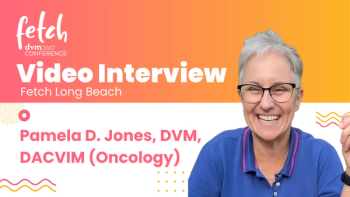
- dvm360 February 2024
- Volume 55
- Issue 2
- Pages: 25
Illuminating the benefits of laser therapy in veterinary medicine

A rehabilitation expert debunks common myths and describes the advantages laser can have on patients at the Fetch conference in Long Beach, California
Similar to acupuncture, massage therapy, and other alternative treatments, laser therapy can be utilized as an alternative or complementary approach to medication for pain management, reducing inflammation, and aiding in wound healing.1 Tom Walsh, DVM, CCRP, MBA, owner of PrimePet Rehabilitation Therapy in Myrtle Beach, South Carolina, shared with attendees at the Fetch dvm360 conference in Long Beach, California the benefits of laser therapy for pets.2 He also discussed common misconceptions about lasers and explained why these myths are untrue.
Walsh argued that laser therapy can decrease pain, support post-operative recovery, and restore function in limbs that may have been impacted by disease or trauma. Even without a previous disease or trauma in the patient’s history, Walsh indicated that laser therapy can boost the immune system and improve overall range of motion and strength in the body. He also recommended laser as a treatment option for patients who do not qualify for surgical intervention.
Case studies
To back up his claims, Walsh shared some real cases he has seen and worked with at his practice.
Max
First up was Max, a 6-year-old Boykin spaniel who got injured while playing outside unexplainably. He had subluxated and blown out a disc in his spine. Max underwent surgery and then came to Walsh a few weeks later for postoperative recovery. “[We started with] 30-minute appointments, 3 times a week. We were also using multiple modalities like electrical stimulation, cryotherapy, [and] massage,” Walsh said. “This particular laser that I used, you can alternate between red and infrared. And the way I like to think of it is the red laser is a little bit broader scheme, whereas infrared I can really dial in anything.”
Walsh also wanted to remind attendees that recovery is not always linear and that dogs can have bad days, too. “You may see some twitching, you may see some neural fibers that are regenerating, but it's not necessarily indicative of, ‘yes, we're on our way to success there.’ With my neural cases, it's a lot of ups and downs sometimes,” he said. However, Walsh explains that consistency is key to seeing results long term.
Max received his laser treatment for 10 months, building up his muscle tone and strength, and Walsh was sure he would be strong enough to walk without his wheelchair soon. Unfortunately, Max was diagnosed with cancer and passed soon after. However, through this case study, Walsh saw the impact of using laser therapy and saw the progress Max had made over the months of treatment.
Madison
Madison was a 13-year-old pug-terrier mix that was adopted at an older age, so her medical history was unknown. However, after being rescued by her owner, she was diagnosed with arthritis and multiple myopathy. Madison was very reluctant to move at all. Walsh explained that he used a red laser on her hips and lumbar spinal area for 11 minutes each, and he told attendees he typically aims for 5 to 10 minutes as his protocol, but this can always be adjusted for a specific patient’s needs. “And we started doing laser therapy to reduce that inflammation all the way from the neck. I've got a PMF, pulsed electromagnetic frequency, disc on her,” Walsh said.
Walsh recommended getting Madison a wheelchair to get her used to moving around as she was gaining her strength back with laser therapy. Walsh also started to combine hydrotherapy with her treatment and with several weeks of sessions, Madison was able to walk on her own without any assistance. She was moving slowly, but with maintaining consistency on her laser treatment, Madison is now able to run around with her housemates.
Takeaways
To summarize his session, Walsh made a few final points about laser therapy for veterinary rehabilitation and debunked the common misconceptions surrounding it. According to Walsh:
- Power alone does not determine therapeutic effectiveness.
- The key to treating orthopedic cases is consistency, not complicated protocols.
- Whether it’s chronic arthritis, wound healing, or neurological conditions, laser therapy is not limited to only treating pain and inflammation.
- Even if the prognosis is uncertain, using laser therapy can have a positive impact for a patient’s quality of life.
And research finds that laser therapy can aid in the following:2
- Treat trauma and restore function
- Increase the speed and success of postoperative recovery
- Improve range of motion
- Regenerate peripheral nerves
- Boost the immune system
- Provide a treatment option for patients in which they are not a candidate for surgery
References
- What is veterinary laser therapy? American Animal Hospital Association. Accessed January 15, 2024.
https://www.aaha.org/your-pet/pet-owner-education/ask-aaha/laser-therapy/ - Walsh T. Why Conventional Thinking About Laser Therapy is Wrong and What That Means to Your Practice. Presented at: Fetch dvm360 conference; Long Beach, California; December 1-3, 2023
Articles in this issue
almost 2 years ago
dvm360® product report: Mobility products, plus cat toothbrush, and morealmost 2 years ago
How to approach pet dental care year-roundalmost 2 years ago
How to apply a phalangeal cast in horsesalmost 2 years ago
AI vs burnoutalmost 2 years ago
Noteworthy news: Fetch conference is headed to Nashvillealmost 2 years ago
Beyond-use dates: Ready or not, USP guidelines will impact your practicealmost 2 years ago
The interviewalmost 2 years ago
It’s “tooth-thirty.” Do you know where your instruments are?almost 2 years ago
AI-powered diagnostics providing individualized patient carealmost 2 years ago
Preventing canine parvovirus infectionNewsletter
From exam room tips to practice management insights, get trusted veterinary news delivered straight to your inbox—subscribe to dvm360.






